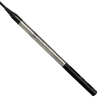YSI ProDSS Turbidity Sensor
Features
- 0 to 4000 FNU measurement range
- T63<2 sec response time
- 0.3 FNU or ±2% of reading accuracy from 0 to 999 FNU
- Free ground shipping
- Expedited repair and warranty service
- Lifetime technical support
- More
Overview
The ProDSS turbidity sensor is a digital smart sensor featuring welded titanium construction for use with the ProDIGITAL family of instruments. Compatible instruments include the ProDSS Meter, ProSwap Meter, and ProSwap Logger.
Mechanics
Turbidity is the indirect measurement of the suspended solid concentration in water and is typically determined by shining a light beam into the sample solution and then measuring the light that is scattered off of the particles which are present. The suspended solid concentration is an important water quality factor and is a fundamental measure of environmental change. The source of the suspended solids varies in nature (examples include silt, clay, sand, algae and organic matter), but all particles will impact the light transmittance and result in a turbidity signal.
Customizable
The ProDSS Turbidity sensor employs a near-infrared light source and detects scattering at 90 degrees of the incident light beam. According to ASTM D7315 method, this type of turbidity sensor has been characterized as a nephelometric near-IR turbidimeter, non-ratiometric. This method calls for this sensor type to report values in formazin nephelometric units (FNU). FNU is the default calibration unit for the ProDSS sensor, but users are able to change calibration units to nephelometric turbidity units (NTU), raw sensor signal (RAW), or total suspended solids (TSS).
ProDSS Smart Sensor Specifications:
| Parameter |
Range | Accuracy* | Resolution |
|---|---|---|---|
|
Conductivity |
0 to 200 mS/cm |
From 100 to 200 mS/cm: ± 1% |
**0.001, 0.01 or 0.1 µS/cm |
|
Temperature |
-5 to 70 °C |
± 0.2 °C |
0.1 °C or 0.1 °F |
| Dissolved Oxygen |
0 to 50 mg/L |
From 0 to 20 mg/L: ± 1% From 20 to 50 mg/L: ± 8% |
0.01 mg/L or 0.1 mg/L |
| pH |
0 to 14 |
± 0.2 |
0.01 |
|
ORP |
-1999 to 1999 mV |
± 20 mV |
0.1 mV |
| Turbidity |
0 to 4000 FNU |
From 0 to 999 FNU: ± 2% From 1000 to 4000 FNU: ± 5% |
0.1 FNU |
| Freshwater Total Algae |
0 to 100 µg/L PC |
r2 = 0.999 |
0.01 µg/L PC |
| Saltwater Total Algae |
0 to 280 µg/L PE |
r2 = 0.999 |
0.01 µg/L PE |
| Nitrate |
0 to 200 mg/L |
± 10% |
0.01 mg/L |
| Ammonium |
0 to 200 mg/L |
± 10% |
0.01 mg/L |
| Chloride |
0 to 1000 mg/L Cl |
± 15% |
0.01 mg/L |
*Reference specification for each sensor for more details on accuracy
** Range dependent
In The News
Wildfire Prevention in the Sierra Nevada Region with the Yuba Watershed Institute
Though recent wildfires have sparked new conversations about wildfire management and response, groups like the Yuba Watershed Institute have been monitoring the forests and water resources of the Sierra Nevada region for decades, managing approximately 5,000 acres of land with the Bureau of Land Management (BLM) and about 7,000 acres in private land partnerships. The goal of the Institute is to work with local communities and land agencies to improve watershed and forestry management through informed practices and public outreach. The goals of the Yuba Watershed Institute are three-fold: Improve the ability of fire suppression agencies like the California Department of Forestry and Fire Protection ( CAL FIRE ) and the US Forest Service.
Read MoreWave Sensors Integration with NexSens Buoys: A Cutting-Edge Solution for Wave Measurment
Real-time wave data supports accurate weather prediction, safe and efficient maritime operations, and provides valuable safety and operating condition information for recreation and commercial fishing. Understanding wave dynamics also helps with the design of protective coastal structures like seawalls, breakwaters, and jetties. It also supports better prediction of their impact on sediment transport and coastal geomorphology. Wave data is a key factor in qualifying and designing offshore wind farms and harnessing kinetic energy for electrical generation. It helps with the understanding of ocean-atmosphere interactions and contributes to studies of sea-level rise and climate change impacts.
Read MoreSpring 2025 Environmental Monitor Available Now
In the Spring 2025 edition of the Environmental Monitor, we highlight partnerships across the world and the importance of collaboration between government agencies, universities, environmental groups, local communities, and other stakeholders. From great white shark research in Cape Cod to monitoring fisheries in Lake Erie, this latest edition underscores partnerships that connect stakeholders in a watershed through environmental data. With an emphasis on data sharing, a combination of real-time and discrete sampling keeps the public and partners informed of environmental conditions. Our writers also sought out science professionals dedicated to working with peers within and outside of the environmental sector.
Read More















